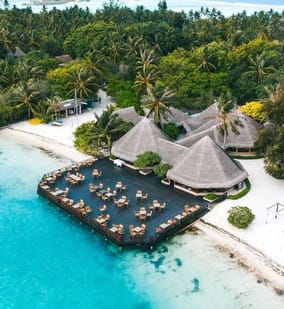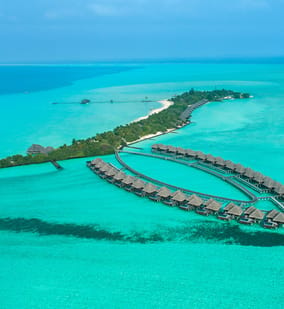Unique Location in the Maldives to See Manta rays and Whale sharks

In recent years the Maldives has earned a reputation as one of the best places in the world for diving. This is hardly a surprise as the country is over 90 per cent water, and the diversity of marine wildlife found underwater is simply astonishing.
Divers, underwater photographers, marine biologists and others interested in the world beneath the surface of the seas are flocking to the country to unravel the various mysteries of the deep and to enjoy its spectacular beauty.
While there are many popular diving spots in the Maldives that tempt divers with their unique aspects and unusual sights, there is one area in the Maldives that has attracted worldwide attention in the last few years due to a unique seasonal phenomenon that occurs there every year.
This area is known as Hanifaru Bay. It has become such a hotspot for marine enthusiasts because it is a feeding aggregation site for two of the biggest plankton feeders in the world, manta rays and whale sharks.
Shortly after tourism was introduced into the Maldives in the late 1970s, the Government became aware of the need to protect some of the more vulnerable areas and species living in the Maldives if they wanted to ensure tourism would remain a sustainable product.
This was accomplished by declaring several of the top dive sites in the country as Marine Protected Areas (MPA). However, Hanifaru Bay is a recent addition to the list since it was declared a MPA in 2009.
Located between Dharavandhoo and Kihaadhuffaru in Baa Atoll (South Maalhosmadulu Atoll) of the Maldives, the Hanifaru Bay MPA actually extends to the area surrounding Hanifaru Island and encompasses a 200m boundary outside the outer reef edge.
Every year, from May through to November, the microscopic creatures known as zooplankton bloom in the area in unusually high density due to the hydrodynamic conditions prevailing in the sea around the area during the period.
This huge spike in zooplankton densities attracts the manta rays and the whale sharks in large numbers to the location, as zooplankton is the favourite food of the two giant animals. When the lunar tide pushes against the Indian Ocean's southwestern monsoon current, a suction effect pulls tropical krill and other plankton from deep water up to the surface.
The current causes the krill to be swept inside the cul-de-sac that is Hanifaru Bay, and although they could make their way off the bay’s coral walls and into the open sea if they stayed near the surface, they can’t, because instinct forces them to dive deeper into the lagoon, away from sunlight.
Thus they get trapped deep in the bowl of the bay, causing a massive concentration of plankton to build and turning the water cloudy, a veritable feast that no plankton feeder, such as manta rays and whale sharks, can resist.
This unique location gained international attention after UNESCO’s declaration of Baa Atoll as a UNESCO Biosphere Reserve in 2011. The astonishing Hanifaru Bay sometimes converged hundreds of mantas in the area for a hypnotic and spectacular ballet of underwater feeding as the 2,000lb giants feasted on Indian Ocean krill while thousands and thousands of tiny silversides swirled about them like glittering fairy dust.
The unique setting of Hanifaru Bay had led mantas to extend their usual repertoire of feeding strategies and develop new ones more suited to the tight confines of the Bay. It has identified manoeuvres performed by the manta rays in Hanifaru Bay that had never before been seen elsewhere.
One of the new manoeuvres observed at Hanifaru Bay was termed “cyclone feeding”, which occurs when 50 or more fish chain feed in the bay and the head of the line catches the tail, causing the chain to spin into a vortex. With more than a hundred giant mantas in the spiral, the chain breaks down, leading to chaos feeding.
There is chaos everywhere, with mantas bumping into each other, and into this chaos comes the languid, beautiful giants known as the whale sharks, each as big as a 40-foot shipping container.
Predictably, these feeding frenzies don’t last too long – an hour at the most – as plankton are consumed in huge quantities. However, it’s for a chance to see experience this short wonder-filled moment that divers, snorkellers and other marine wildlife enthusiasts are flocking to the Maldives.
Swimming with whale sharks or mantas is an experience, but watching these amazing species feeding together in a chaotic underwater dance is something that no diver would want to miss.








